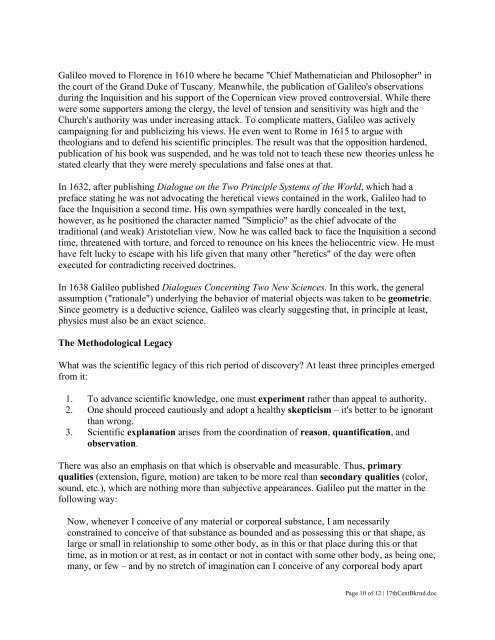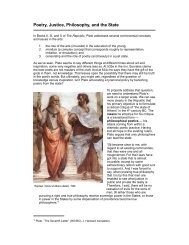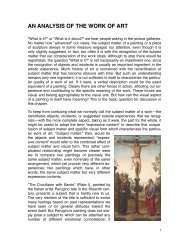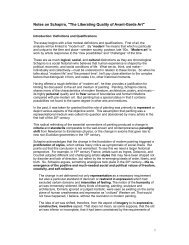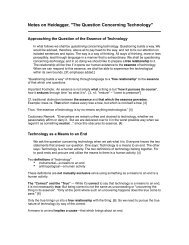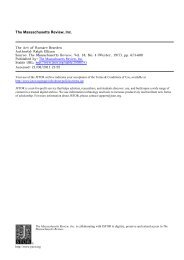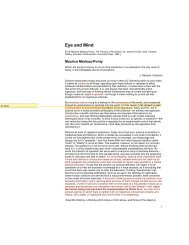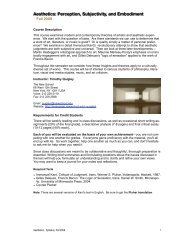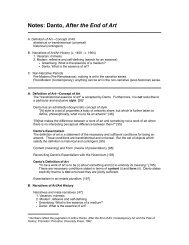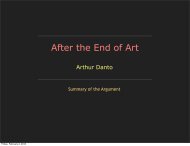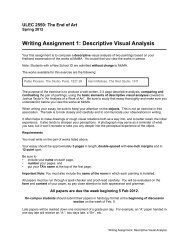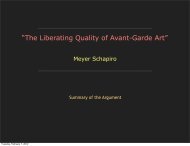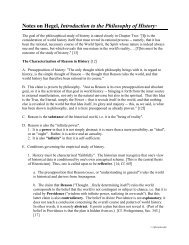Galileo moved <strong>to</strong> Florence in 1610 where he became "Chief Ma<strong>the</strong>matician and Philosopher" in<strong>the</strong> court of <strong>the</strong> Grand Duke of Tuscany. Meanwhile, <strong>the</strong> publication of Galileo's observationsduring <strong>the</strong> Inquisition and his support of <strong>the</strong> Copernican view proved controversial. While <strong>the</strong>rewere some supporters among <strong>the</strong> clergy, <strong>the</strong> level of tension and sensitivity was high and <strong>the</strong>Church's authority was under increasing attack. To complicate matters, Galileo was activelycampaigning for and publicizing his views. He even went <strong>to</strong> Rome in 1615 <strong>to</strong> argue with<strong>the</strong>ologians and <strong>to</strong> defend his scientific principles. The result was that <strong>the</strong> opposition hardened,publication of his book was suspended, and he was <strong>to</strong>ld not <strong>to</strong> teach <strong>the</strong>se new <strong>the</strong>ories unless hestated clearly that <strong>the</strong>y were merely speculations and false ones at that.In 1632, after publishing Dialogue on <strong>the</strong> Two Principle Systems of <strong>the</strong> <strong>World</strong>, which had apreface stating he was not advocating <strong>the</strong> heretical views contained in <strong>the</strong> work, Galileo had <strong>to</strong>face <strong>the</strong> Inquisition a second time. His own sympathies were hardly concealed in <strong>the</strong> text,however, as he positioned <strong>the</strong> character named "Simplicio" as <strong>the</strong> chief advocate of <strong>the</strong>traditional (and weak) Aris<strong>to</strong>telian view. Now he was called back <strong>to</strong> face <strong>the</strong> Inquisition a secondtime, threatened with <strong>to</strong>rture, and forced <strong>to</strong> renounce on his knees <strong>the</strong> heliocentric view. He musthave felt lucky <strong>to</strong> escape with his life given that many o<strong>the</strong>r "heretics" of <strong>the</strong> day were oftenexecuted for contradicting received doctrines.In 1638 Galileo published Dialogues Concerning Two New Sciences. In this work, <strong>the</strong> generalassumption ("rationale") underlying <strong>the</strong> behavior of material objects was taken <strong>to</strong> be geometric.Since geometry is a deductive science, Galileo was clearly suggesting that, in principle at least,physics must also be an exact science.The Methodological LegacyWhat was <strong>the</strong> scientific legacy of this rich period of discovery? At least three principles emergedfrom it:1. To advance scientific knowledge, one must experiment ra<strong>the</strong>r than appeal <strong>to</strong> authority.2. One should proceed cautiously and adopt a healthy skepticism – it's better <strong>to</strong> be ignorantthan wrong.3. Scientific explanation arises from <strong>the</strong> coordination of reason, quantification, andobservation.There was also an emphasis on that which is observable and measurable. Thus, primaryqualities (extension, figure, motion) are taken <strong>to</strong> be more real than secondary qualities (color,sound, etc.), which are nothing more than subjective appearances. Galileo put <strong>the</strong> matter in <strong>the</strong>following way:Now, whenever I conceive of any material or corporeal substance, I am necessarilyconstrained <strong>to</strong> conceive of that substance as bounded and as possessing this or that shape, aslarge or small in relationship <strong>to</strong> some o<strong>the</strong>r body, as in this or that place during this or thattime, as in motion or at rest, as in contact or not in contact with some o<strong>the</strong>r body, as being one,many, or few – and by no stretch of imagination can I conceive of any corporeal body apartPage 10 of 12 | 17thCentBkrnd.doc
from <strong>the</strong>se conditions. But I do not at all feel myself compelled <strong>to</strong> conceive of bodies asnecessarily conjoined with such fur<strong>the</strong>r conditions as being red or white, bitter or sweet,having sound or being mute, or possessing a pleasant or unpleasant fragrance. On <strong>the</strong> contrary,were <strong>the</strong>y not escorted by our physical senses, perhaps nei<strong>the</strong>r reason nor understanding wouldever, by <strong>the</strong>mselves, arrive at such notions. I think, <strong>the</strong>refore, that <strong>the</strong>se tastes, odors, colors,etc., so far as <strong>the</strong>ir objective existence is concerned, are nothing but mere names for somethingwhich resides exclusively in our sensitive body (corpo sensitivo), so that if <strong>the</strong> perceivingcreatures were removed, all of <strong>the</strong>se qualities would be annihilated and abolished fromexistence. But just because we have given special names <strong>to</strong> <strong>the</strong>se qualities, different from <strong>the</strong>names we have given <strong>to</strong> <strong>the</strong> primary and real properties, we are tempted in<strong>to</strong> believing that <strong>the</strong>former really and truly exist as well as <strong>the</strong> latter. 7Typical of <strong>the</strong> "new scientist" was <strong>the</strong> view that physical reality is characterized by matter inmotion. The behavior of matter conforms <strong>to</strong> simple ma<strong>the</strong>matical laws. Thus, a mechanistic andquantitative view of nature must replace <strong>the</strong> teleological and qualitative view.This new approach <strong>to</strong> <strong>the</strong> understanding of nature also raised <strong>the</strong> issue of free will anddeterminism, as well as questions about <strong>the</strong> relation and priority of phenomenal experience(appearance) and objective relations (reality), leading <strong>to</strong> a re-emergence of dualism as one wayof reconciling materialism with Christian doctrine.III. Mysticism, Pla<strong>to</strong>nism, and <strong>the</strong> Great Chain of BeingIn addition <strong>to</strong> <strong>the</strong> developments in applied ma<strong>the</strong>matics and scientific experimentation during <strong>the</strong>Renaissance, <strong>the</strong> revival of Pythagoreanism and Pla<strong>to</strong>nism in <strong>the</strong> fifteenth and sixteenth centuriesalso stimulated an interest in various forms of mysticism and <strong>the</strong> occult sciences (astrology,numerology, alchemy, etc.) To separate <strong>the</strong>se elements from <strong>the</strong> scientific concepts and practicesof <strong>the</strong> time would be <strong>to</strong> ignore an important aspect of late medieval and renaissance thinkingabout human experience, <strong>the</strong> natural world, and <strong>the</strong>ir place in <strong>the</strong> "Great Chain of Being". 8The case of ma<strong>the</strong>matics is of special importance because of <strong>the</strong> significance of quantificationin <strong>the</strong> rise of modern science, but <strong>the</strong> occult or mystical influence of late Hellenisticphilosophy had a much deeper impact on sixteenth-century thought than this alone. Implicit inneo-Pla<strong>to</strong>nism and <strong>the</strong> Christian traditions was <strong>the</strong> belief in a unity of nature, a unity thatencompassed God and <strong>the</strong> angels at <strong>the</strong> one extreme and man and <strong>the</strong> terrestrial world at <strong>the</strong>o<strong>the</strong>r. Along with this was a continued belief in <strong>the</strong> truth of <strong>the</strong> macrocosm-microcosmrelationship, <strong>the</strong> belief that man was created in <strong>the</strong> image of <strong>the</strong> great world, and that realcorrespondences do exist between man and <strong>the</strong> macrocosm. 9Neo-Pla<strong>to</strong>nism also emphasized beauty, order and <strong>the</strong> importance of <strong>the</strong> sun as <strong>the</strong> source oflight, nutrition, and life on earth. Such views contributed <strong>to</strong> a "climate of opinion" in which itwas quite natural <strong>to</strong> think of <strong>the</strong> universe as based on ma<strong>the</strong>matical relations, and <strong>to</strong> conceive of7 Galileo, The Assayer (1623), in Michael R. Mat<strong>the</strong>ws (ed.), The Scientific <strong>Background</strong> <strong>to</strong> <strong>Modern</strong> Philosophy: SelectedReadings, Indianapolis and Cambridge: Hackett, 1989, 56f.8 Debus, op. cit., 11-15.9 Ibid., 12.Page 11 of 12 | 17thCentBkrnd.doc


